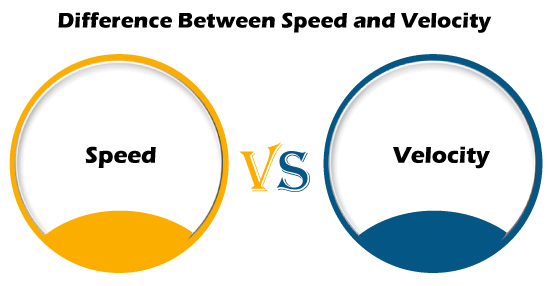Science, mathematics, and other subjects are inventions by humans. It was essential so everyone can know more about the world around them. Mathematics and physics are co-related. Many terms from physics are derived from mathematics to making things more apparent to the learners. Some of the words include speed, velocity, force, and work.
Speed and velocity are a few of the exciting terms of physics. We use them in our daily life, but they don’t mean different to us. Most people are correlating speed and velocity as the same word. However, physics and math make these two words very different from each other.
Keep reading if you want to know more about the difference between speed and velocity. Before you find out the differences, let’s learn the terms speed and velocity separately.
How would you find out who the faster 100m sprinter is? Usain Bolt (the current fastest man) or a Cheetah (the fastest land mammal)?
To make a fair comparison, we need to find the speed of Usain Bolt and Cheetah over 100m.
What is speed?
The rate at which an object covers a certain distance is known as speed. Speed is the distance moved per unit. You can also know the speed as the rate of change of position of an object in any direction. Speed has only direction but no magnitude. Hence it’s a scalar quantity. Speed is calculated through: Speed= distance traveled/time taken. It can also be written as s=d/t.
To know more about speed, the physicists have further categorized it into four types. Those are Uniform speed, Variable speed, Average speed, and instantaneous speed.
When an object covers equal distance in equal time intervals, it is known as Uniform speed.
When an object covers different distances at equal time intervals, then it’s called Variable speed.
Average speed is calculated by dividing the total distance traveled by the total time taken.
The speed of an object at a particular instant is known as its instantaneous speed. It is when an object is moving at a variable speed.
Speedometers are placed in the vehicle to measure their speed. It tells you how far you go in an hour if you maintain a constant speed. Odometers are used to measure the
distance covered by a vehicle. Students take help from the graph Aswell. You can use the distance-time graph to calculate the speed of an object.
What are scalar and vector quantities?
When you study quantities, you often go through the word’s scalar and vector quantities. These two terms have different meanings or definitions. A physical quantity with the only magnitude is known as a scalar quantity—speed, area, volume, mass, time, or electric charge. Just a single number describes it.
Some physical quantities do not even have a direction, so they are just explained as their numerical value with their units.
A vector quantity is also a physical quantity. They are essential when studying motion. However, it has both magnitude and direction: weight, velocity, acceleration, and force.
What is velocity?
Speed and velocity help us to know how fast or slow an object is moving. Sometimes, it’s required to know about two or more objects and differentiate which one is moving faster. Yes, it’s easy to know and tell which one is faster if the starting point and the direction are the same for both. Just like some athletes running on a road. But what if we want to compare two objects that are moving in opposite or different directions?
Then this term, velocity, comes to the rescue. An object’s velocity can be defined as the rate of change of the object’s position concerning a frame of reference and time. Is it becoming too difficult to understand this explanation? Let’s make it easier. To find the velocity of a specific object, you would need its direction and magnitude.
Velocity is the rate of change of displacement. The SI unit of velocity is meter per second (ms-1). The velocity of an object said to accelerate when either its magnitude or direction starts changing. Constant velocity is the most uncomplicated form of motion. You must have observed constant motion whenever a body slides over a horizontal and low friction surface.
It is essential to know about initial and final velocity. Initial velocity is termed when the gravity first applies force on that object. And the final velocity calculates the speed and direction of that moving object when it has reached its final acceleration.
How to find the final velocity?
· Find the object’s initial velocity by dividing the time it took for the object to travel a given distance by the total distance. Use this equation: V = d/t. Where V is the velocity, d is the distance, and t is the time.
· Find the acceleration of that object by dividing the object’s mass by force. Then multiply the answer by the time it took for it to accelerate.
· Add the quantities obtained from the original velocity and acceleration to obtain the final velocity.
What is the difference between speed and velocity?
If the terms Speed and velocity turned out confusing for you, you could look at their differences side by side. Let’s talk about the primary difference between speed and velocity. Speed tells us that how fast an object is moving. Velocity tells us the direction of the object and its speed too. Speed can define as a function of distance traveled.
On the contrary, velocity is a function of displacement. The velocity of a body at any given time is its Instantaneous velocity. The total displacement / the total time is the calculation of an average velocity.

Definition
Speed: It the rate at which a particular distance covered by an object.
Velocity: Velocity refers to the rate at which an object changes its position in a particular direction.
Quantity
Speed: It is a scalar quantity
Velocity: It is a vector quantity.
Indication
Speed: It shows how fast a body is moving.
Velocity: It shows how fast a body is moving and its direction.
Value
Speed: The answer can never be a zero or in a negative number
Velocity: The answer can be positive, negative, or even a zero.
SI Unit
Speed: Its SI unit is m/s.
Velocity: Its SI unit is also m/s.
Change of direction
Speed: It calculates no matter if a body changes direction.
Velocity: It cannot calculate if the object changes its direction while moving.
Interrelation
They did not interrelate. Speed can either be the same as velocity or changed. On the other hand, speed can be the same, but the velocity of an object changes.
Calculation
Speed: Distance traveled/Time taken
Velocity: Displacement/Time taken
Before ending this blog, we would like to give a question to ponder on. We hope you can quickly answer it in your mind after learning a lot about kinematics today.
In 1987, Gregory Robertson, a skydiving instructor, carried out the most daring rescue of his lifetime. Upon seeing his fellow skydiver, Debbie Williams, falling past him unconscious in midair, Robertson instinctively increased his speed to go after her. He caught up with her and released both their parachutes barely seconds from crashing to the ground.
Also read: Difference between HTML and xml






